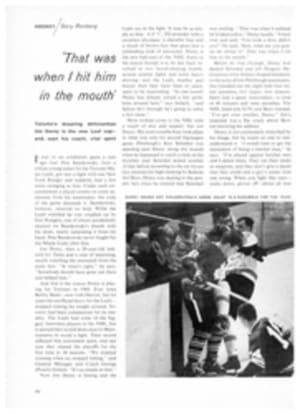
Swimming Ben, or How a New Nation Kept Afloat
Schoolchildren may remember Ben Franklin best as a somewhat incautious kiteflyer, journalists as founder of The Saturday Evening Post, mailmen as the first Postmaster General and romantically inclined historians as a diplomat with a fine flair for a Parisian boudoir. But sports fans, too, have a vested interest in America's first Renaissance man, for Franklin was not only all these other things but a superb swimmer as well—so good, in fact, that his skill at swimming very nearly submerged all his other talents.
Franklin learned to swim as a boy in Boston and kept it up throughout his life. On frequent trips across the Atlantic he amused himself and startled his fellow passengers by leaping overboard for a daily bath while his vessel surged ahead under full sail.
When Ben was in his 40s and living in Philadelphia on an estate washed by the Schuylkill River he swam for an hour or two every night, in his 60s as U.S. minister to France he swam with children of his friends in a pool on his estate, and in his 70s he wrote in his diary: "Went at noon to bathe in Martin's salt water hot-bath and, floating on my back, fell asleep and slept near an hour to my watch, without sinking or turning! A thing I never did before, and should hardly have thought possible."
Apart from lifting printers' blocks as a younger man and pacing furlongs in his room, swimming was the only exercise Franklin took, and it helped keep him vigorous almost to the end of his 84 years. He thought swimming, in addition to being pleasant and useful, was an excellent medicine. He recommended an hour or two of swimming in the evening to insure a cool sleep on the hottest nights. No wonder the English took to calling him the "Water-American."
Such faith in natation was quite unusual in Franklin's time. He himself acquired it as a boy when he got hold of a textbook on the sport by a French writer named Thevenot. The real problem in learning to swim, as Franklin saw it, was to get confidence in the power of water to support the body. The way to learn this, he decided, is to choose a place where the bottom drops very slowly. Walk out "coolly" until the water is up to your chest and then turn around, and, with your face to the shore, throw an egg into the water where you can see it but where you can't reach it without diving for it. Then plunge forward after the egg. You will see that it isn't easy to get under the water to the egg; you really have to work at it to force your way downward. That, said Franklin, should convince even the most skeptical that water is buoyant. At the same time, without even thinking about it, he will be learning how to stroke.
Swimming always brought out the inventiveness in Franklin's mind. When he was still just a boy he tried swimming with two oval palettes, each about 10 inches long, with thumbholes just like painters' palettes. Using these as paddles, he found he swam much faster but that they tired his wrists. He also anticipated present-day flippers with a kind of sandal for his feet but he had trouble adapting them to his stroke, and they didn't work out well.
Franklin's first experiments with kites were connected with swimming rather than electricity. One day, when he was playing with a kite near a pond, it occurred to him that the kite could just as well do his swimming for him. So he held onto the kite and let it tow him back and forth across the pond, which was about a mile wide. He never tried the trip himself but he thought it not impossible to cross the English Channel in that manner from Dover to Calais, though he admitted "the packetboat would still be preferable."
Before Franklin was 20 he traveled to London in order to learn more about printing and bookselling in hopes of setting up his own business in Philadelphia. One of his fellow journeyman printers was a young man named Wygate whom Franklin taught to swim in only two lessons. Wygate was better educated than most printers and had a wide circle of friends among the gentry. A group of them invited the two young printers on an excursion by boat to Chelsea. Wygate boasted so of Franklin's swimming that everyone begged the American to show what he could do. Accordingly, he peeled off his clothes and jumped into the river, swimming some four miles from Chelsea to Blackfriars, all the way performing on and under the water the clever tricks he had mastered back in Boston.
Everyone was deeply impressed. Sir William Wyndham, former Chancellor of the Exchequer and friend of Swift and Bolingbroke, heard about Franklin's feats on the river as well as of his rapid teaching methods. He sent for Franklin and explained that he had two sons almost grown and about to be sent on their travels. He wanted them to be taught swimming by Franklin.
Franklin considered. Sir William was one of England's most distinguished men, and any association with him would be to Franklin's improvement and advantage. He was strongly tempted to stay. If he did he could make a great deal of money by opening a swimming school, since no one in London could begin to approach his mastery of the sport. On the other hand, Franklin had been promised a good job back in Philadelphia, the boat was soon to sail and Sir William's two sons were not due to arrive in London for some time.
Reluctantly, Franklin turned down the offer and went back home. Had the offer been made earlier, he often said, he probably would have accepted it, stayed on in London and become a swimming teacher. The science of natation, in that case, might have made prodigious advances, but, without Franklin's buoyant wit and wisdom, the future United States of America might well have sunk with scarcely a trace.

